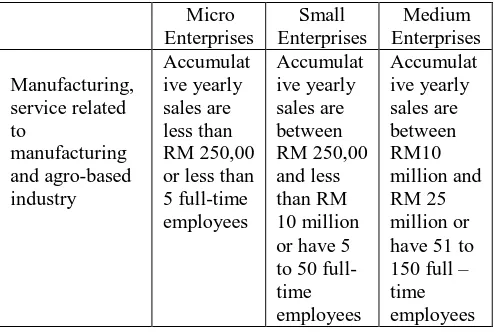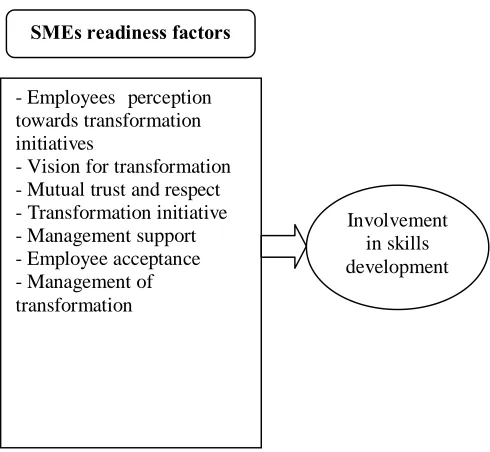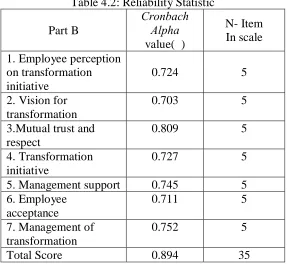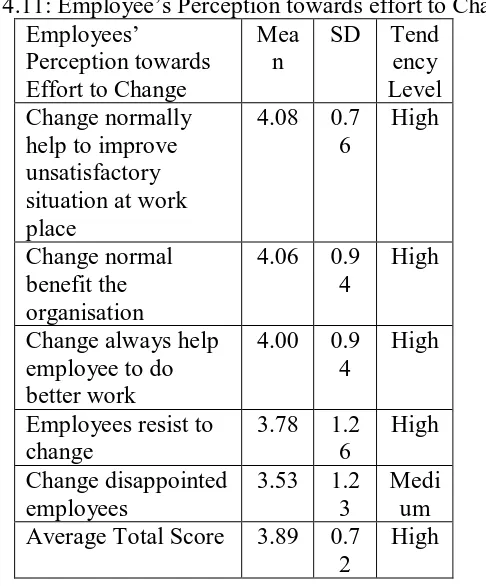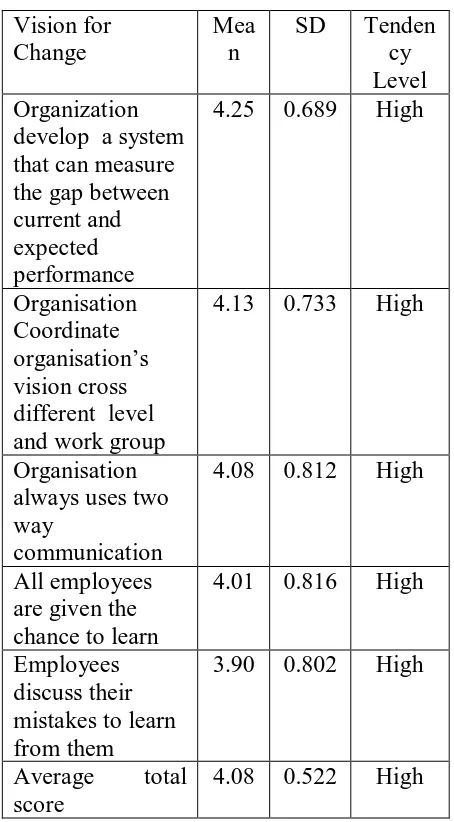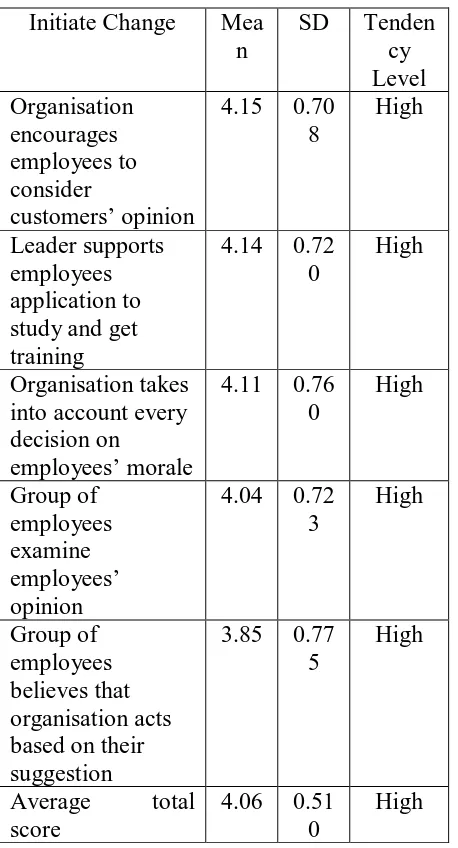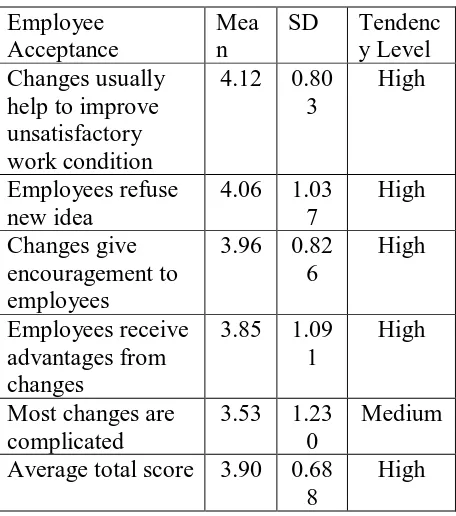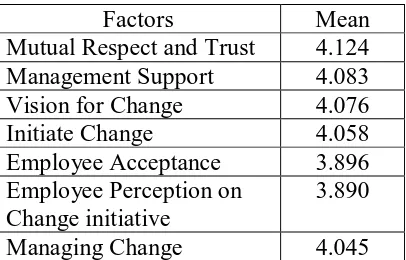539
Small medium Entreprises (SME) Readiness to Participate in
Workforce Skills Development
Haris Bin Md. Noor, ,Nor Kamariah Binti Kamaruddin ,Mohd Nazir Bin Mohd Adi, Abd Rahman Bin Ahmad ,Wan Nordiana Syazmiera Binti Wan Saidi ,Abdul Ghafar Bin
Abdul Rahman
Faculty Of Technology Management And Business University Tun Hussein Onn Malaysia
harisn@uthm.edu.my
Abstract
The purpose of this study is to identify the readiness factors of SMEs to participate in workforce skills development. Many changes have occurred regarding the workforce skills needed in the workplace operation, thus forcing the organizations to emphasize on knowledge-based workforce. Workforce needs to acquire new skills to be competitive and ready to accept the current and upcoming changes. SMEs needs to involve in on-going training of their workforce in order to guarantee its skills resources and challenges to be faced, due to the increases of competitiveness and technology advancement. Questionnaires were distributed to 200 employees of SMEs in the food manufacturing sector in Batu Pahat, Johor. The preliminary analysis of the questionnaires showed that the item regarding mutual trust and respect with mean score of 4.12 is the most dominant factor of workforce readiness to participate in skills development, thus indicate the high central of tendency towards readiness of participation. Whilst, the overall outcome for all the readiness factors regarding SMEs participation in employees skills development showed high central of tendency with mean range from 3.89 – 4.12. It is much suggested that SMEs and training provider should allocate proper time or schedule for SMEs workforce to participate in skills development programme. In future the findings will be strengthening through in-depth analysis to determine the significant result that can be generalised throughout SMEs in Malaysia.
540
Introduction
Every business including SMEs have to continuously train and improve their workforce skills in order to increase their level of competitiveness in the local and international market. The skills needed in workplace have gone through many changes and organisations need to emphasize on workforce that are based on knowledge, as today’s and tomorrow’s workers need to master varieties of skills, able to stay competitive and ready to accept any changes (Gates et al., 1996).
Research background
SMEs should be aware of the importance of skills development and programmes that can improve the quality of workforce skills. This is much being emphasised by the government for the SMEs to be seriously involved in all training activities and skills development programmes organised by the Ministry of Human Resource. The noble initiatives and supports done by the government is through the Ministry of Human Resources, which introduced the Human Resources Development Fund (HRDF) in 1993, which was aimed to encourage and improve human resources training and provide enough employees with specific skills and techniques in line with new and more automatic technologies production and competitive business (PSMB, 2009).
Next, in the attempt to strive to be developed country status by the year of 2020, more emphasis needs to be put to re-training and enhancement in human resource skills. Re-training and skills enhancement are also crucial in improving the quality of human resource so that they can be versatile and able to blend in quickly in line with the changes of technology and business environment.
The expenses in skills development and training give SMEs the advantage of skilled human resource and thus lead to higher productivity. Nevertheless, the lack of skilled employees is still crucial in the field that involve experienced and professional employees. This lead to lower supply of skilled workforce compared to the number of demand results in the lack of skilled employees.
Every business, including SMEs, need to always train and increase their employees’ skills, in order to increase their competitiveness level. Continuous training for both employees and employers is the only way for SMEs to ensure that their human resource skills can overcome todays challenge, in terms of competition enhancement and technology. Expenses and focus on training will give SMEs an advantage, which is skilled human resource, and hence contribute to higher productivity (SMEinfo, 2006).
Statement of problem
541
developed countries. Therefore, we need to increase the composition of skilled employees to at least 37% before 2015 in order for us to be a developed country. In order to encourage the participation of SMEs or the private sector in training skilled employees, government will take the step to expand the coverage of Human Resources Development Fund and Small and Medium Industrial Corporation grants in helping employers from small and medium industry to train their employees (RMK10, 2011-2015).
There was an issue that state the involvement of SMEs in official training programme for their employees is less. Most of them choose to do on-the-job-training or apprenticeship. Plus, most of the training scheduled is not always give the chance for their employees to add new knowledge as it is not suitable for their field of work (Antonacopoulou, 2002).
There are some organisations that are still refused to involve in skills development programmes for their employees, although they know the outcome of the trainings. There are also organisations that are not interested in sending their employees to courses. A few employers said that they will have fewer employees to work in the factory and they are afraid that the skilled or well-trained employees will seek for other work with better or higher payment or become a higher bid if they ought to send their employees on skills development programmes (PSMB, 2009).
Thus, this research is conducted in order to identify the SMEs readiness to increase their participation in workforce skills development; What are the SME readiness factors that help to enhance involvement in workforce skills development?
Research scope
This research will be conducted on SMEs employees or workforce involved in food manufacturing sector around Batu Pahat, Johor.
Importance of research
This research is important in order to identify the SMEs factors that help to increase the involvement in workforce skills development. This research is conducted to create awareness among SMEs about the importance of their readiness to increase their involvement in skills development for workforce. This will also help employees to improve the skills that they own along with new skills in line with the current needs, henceforth contributes to the organisation’s productive growth.
Skills development is important in an organisation in order to create competent, well-trained, knowledgeable and skilled employees. It is to increase organisational performance and being able to compete in the market along with the development of new technologies and at the same time escalate the tradition of training among employers.
542
parties played their part in the attempt to provide various services in the field of employees’ skill development.
In addition, this research is also important in increasing literary sources and references for researches in the same field in the future.
Literature Review
Introduction
In this chapter, researchers explain important keywords related with some definitions and concepts based on previous researches done by local or international researchers concerning the same issues with the study at hand.
Definition of SMEs readiness
Armenakis et al. (1993) and Eby et al., (2000) states that readiness towards transformation portrays employee’s perception in determining the level of readiness of an organisation to encounter changes through the eyes of the organisation’s members. Readiness towards transformation can be obtained by creating a good attitude towards changes.
Readiness is a pre-condition needed for a person or organisation to succeed in facing organisational change (Holt, 2000). Furthermore, Holt clarifies that readiness for a comprehensive approach to change at the same time raised by content (what is changing), process (how changes start to take place), context (state where changes occured) and individual (their characteristics will be asked towards changes).
SMEs involvement in skills development
Simpson & Weiner (2002) claims that participation means to take part or involve in something. It is a state shared with other people or accepting or having a part of something. Thus, the basic concept of participation is involvement or partnership especially in certain activity. Meanwhile for members of the organization, they will feel satisfied and more committed with the organisation’s leadership if they are given the freedom to give ideas or opinions in any activities they involved in.
Skills development
543
However, (Huang, 2001) clarifies that skills development is a process where individual learn through experience in order to be more skilful. Facts are to use skills and knowledge learned in training not only for the present but also future performance. This also involve psychological concept of level of development maturity and increase self-confidence.
Besides, skills development also involved changes in behaviour after the training process. It also changes the way we think and be more motivated. Thus, work performance and organization will be improved (Fisher et al., 1999).
Importance of skills development
Organisation provides training as they want the organisation and employees to be familiar with the new situation or teach them on how to do their initial work. A few organisations also want to improve the current performance of their worker that are unable to do their work effectively as instructed, or as a preparation for future promotion, or to create changes in the form of design, process or technology in their present jobs (Fisher et al. 1999).
Small and Medium Industry(SMEs)
[image:5.612.183.430.420.586.2]Small and medium industry can be divided into three categories which are micro, small and medium industry, as the table below.
Table 2.1: PKS Category (SMEs 2005)
Previous researches
Haris et al. (2011), research on identifying the factors that can influence participation in skills development programme organized or monitored by PSMB. The influencing factors were the internal factor (organisation) and external factor (training provider) related to the implementation of participation towards skills development programme. There were a total of 65 questionnaires collected from whole manufacturing industry. The study showed that both internal and external
544
factors contribute largely to organisation participation in human resources skills development programme. However, external factors gave highest influence compared to internal factors. The highest external factor is PSMB factor and the highest internal factor is organisation influence. The results show that the function of PSMB in skills development programme cannot be overlooked. The results also prove that all industries acknowledge that skills development plays an important role in maintaining their employees’ skills and maintaining the level of their competitiveness.
In addition, Alfonsus B. Susanto (2008) made a research on the organisation readiness aspects to change, which consists of perception towards efforts to change, vision to transform, transformation initiatives, trust and respect, changes, management support, acceptance, and how organisation manage their transformation process. In measuring organisation readiness for changes, a research on changes readiness was done in X Company, a manufacturing company in Indonesia. The research was done by using survey forms. There were 153 employees that took part in the observation, where 88% of the manufacturing company were dominated by male employees. Due to the index is much higher than the threshold (2, 5), it can be concluded that the level of readiness is at the ready stage.
It is clear that there are 7 organisation readiness factors, which are perception towards transformation efforts, vision to change, transformation initiative, trust and respect, transformation, management support, acceptance, and how organisation manages their transformation process.
[image:6.612.244.489.439.665.2]Theoretical framework
Figure 2.1: Theoretical Framework (Adapted from Alfonso, 2008)
SMEs readiness factors
- Employees’ perception towards transformation initiatives
- Vision for transformation - Mutual trust and respect - Transformation initiative - Management support - Employee acceptance - Management of transformation
545
Research Metodology
The research involved quantitative and descriptive analysis. The data and information retrieved from the questionnaire was analysed using SPSS (Statistical Packages for the Social Sciences) to answer the research question mentioned earlier in this paper. This research questionnaire was adapted from Alfonso, 2008, “Readiness Factors for SMEs to Participation in Workforce Skills Development .
Research population and sample
The research population involved workers from 70 SMEs in food manufacturing sector around Batu Pahat district in the state of Johore.
According to Krejcie and Morgan (1970), for a population of 70 SMEs, the sample needed is 59 SMEs. Therefore, at least 59 SMEs were needed to undertake this research. Researches distributed 200 questionnaires to the employees of 59 SMEs in Batu Pahat with return result of 71.19% with a number of 142 respondents from 42 SMEs.
Data Analysis
Reliability Test
[image:7.612.163.450.446.710.2]Based on table 4.2, the reliability of coefficient value of all the readiness factors showed high alpha results.
Table 4.2: Reliability Statistic
Part B
Cronbach Alpha
value(α)
N- Item In scale
1. Employee perception on transformation initiative
0.724 5
2. Vision for transformation
0.703 5
3.Mutual trust and respect
0.809 5
4. Transformation initiative
0.727 5
5. Management support 0.745 5 6. Employee
acceptance
0.711 5
7. Management of transformation
0.752 5
546
Readiness Factors descriptive test
This value explains the average central of tendency level for every readiness factors.
Table 4.10: Central of Tendency Level: (Mohd Najib, 1994)
Min Score Level
1.00 until 2.33 Low 2.34 until 3.67 Medium 3.68 until 5.00 High
[image:8.612.189.432.294.587.2]Factor of Employee’s Perception towards Effort to Change
Table 4.11: Employee’s Perception towards effort to Change Employees’
Perception towards Effort to Change
Mea n
SD Tend ency Level Change normally
help to improve unsatisfactory situation at work place
4.08 0.7 6
High
Change normal benefit the organisation
4.06 0.9 4
High
Change always help employee to do better work
4.00 0.9 4
High
Employees resist to change
3.78 1.2 6
High
Change disappointed employees
3.53 1.2 3
Medi um Average Total Score 3.89 0.7
2
High
547
[image:9.612.193.420.144.555.2]Factor of Vision for change
Table 4.12: Vision for Change
Vision for Change
Mea n
SD Tenden cy Level Organization
develop a system that can measure the gap between current and expected performance
4.25 0.689 High
Organisation Coordinate organisation’s vision cross different level and work group
4.13 0.733 High
Organisation always uses two way
communication
4.08 0.812 High
All employees are given the chance to learn
4.01 0.816 High
Employees discuss their mistakes to learn from them
3.90 0.802 High
Average total score
4.08 0.522 High
548
[image:10.612.194.420.145.504.2]Factor regarding Mutual trust and respect
Table 4.13: Factor Mutual Trust and Respect Mutual Trust and
Respect
Mea n
SD Tenden cy Level Mutual respect
among employees in Organization
4.25 0.8 2
High
Employees spend time to create trust among them
4.25 0.6 9
High
Employees give open and honest feedback among them
4.08 0.8 1
High
Group members treat each other equally without barriers of position, culture and others
4.02 0.9 3
High
Organisation encourage
employees to give response to solve problem
4.01 0.8 2
High
Average total score 4.12 0.6 2
High
549
[image:11.612.194.423.189.613.2]Factors to Initiate Change
Table 4.14: Factors to Initiate Change
Initiate Change Mea n
SD Tenden cy Level Organisation
encourages employees to consider
customers’ opinion
4.15 0.70 8
High
Leader supports employees application to study and get training
4.14 0.72 0
High
Organisation takes into account every decision on
employees’ morale
4.11 0.76 0
High
Group of employees examine employees’ opinion
4.04 0.72 3
High
Group of employees believes that organisation acts based on their suggestion
3.85 0.77 5
High
Average total score
4.06 0.51 0
High
550
[image:12.612.192.419.168.611.2]Factors on Management Supports
Table 4.15: Factors on Management Supports
Factors on Management
Supports
Mean SD Tendency Level
Leader leads and provides guidance to immediate employees
4.25 0.706 High
Leader ensures organisation action is in line with
organisation’s value
4.11 0.735 High
Leader gives power to subordinate to help in
achieving organisation’s vision
4.05 0.784 High
Leader always seeks for chances to learn
4.07 0.787 High
Organisation collaborates with outside community
3.94 0.665 High
Average total score
4.08 0.519 High
551
[image:13.612.193.421.171.429.2]Factors for Employee Acceptance
Table 4.16: Factor for Employee Acceptance
Employee Acceptance
Mea n
SD Tendenc y Level Changes usually
help to improve unsatisfactory work condition
4.12 0.80 3
High
Employees refuse new idea
4.06 1.03 7
High
Changes give encouragement to employees
3.96 0.82 6
High
Employees receive advantages from changes
3.85 1.09 1
High
Most changes are complicated
3.53 1.23 0
Medium
Average total score 3.90 0.68 8
High
Results showed regarding employees acceptance, most of the items have high central of tendency towards readiness of employees in skills development, Mean 3.90. The item with the highest central of tendency is “Changes usually help to improve unsatisfactory work condition” with the mean value of 4.12 towards employees readiness in skills development. There is only one item with medium central of tendency, Mean 3.53 toward employees readiness in skills development. This over all indicated that employees acceptance do shows high central of tendency of employees readiness in skills development.
552
Table 4.18: Summary of SMEs Employees Readiness Factors to Participate in Skills Development
Factors Mean
Mutual Respect and Trust 4.124 Management Support 4.083 Vision for Change 4.076 Initiate Change 4.058 Employee Acceptance 3.896 Employee Perception on
Change initiative
3.890
Managing Change 4.045
The overall results showed that the employees readiness factors towards participation in skills development have high central of tendency, Mean between 3.89 – 4.12. This finding indicated that all these factors have the tendency to influence the participation of employee in skills development among SMEs in the food sector. The objective of this research, which is to identify the SMEs employees readiness factors to participate in skills development among entrepreneur in Batu Pahat, has been answered. This finding also showed that the mutual trust and respect factor has the highest central of tendency level to encourage participation of employees’ in skills development, Mean of 4.12..
Conclusion And Suggestion
The results of this research shows that all the readiness factors encourages SME employees to participate more in skills development. The mutual trust and respect factor is the most dominant among readiness factor with the highest overall mean value in encourages SME employees to participate more in skills development.
Understanding SMEs readiness to participate in skills development is explains through Fishben and Ajzen’s (1980) theory of planned behaviour. They start the theory with the premise that an attitude towards behaviour starts with the trust on the behaviour. Thus, attitude is an important determinant for any form of behaviour. Traditionally, the measurement for attitude can be done through one attitude towards an object or event
SMEs’ desire to learn is affected by skills’ utility value, the knowledge that they are seeking for and skills that are considered useful to them and their business. With the mastery of knowledge and skills needed, confidence and self-efficacy will increase and thus causing them to be ready to do something (Bandura 1994).
Based on the model used in the research done by Model Alfonsus B. Susanto (2008), the level of readiness for the whole factors studied is perfect.
553
The research scope in terms of research area and focus of the research can be extended so that the research can provide more provide authentic data. The focus of the research can also be done to a larger industry. It is also suggested that use more than one instrument such as interview and survey form. This allows the data collected to be more accurate and vary.
Conclusion
554
References
Ajzen, I. & Fishbein, M. 1980. Understanding Attitudes And Predicting Social Behavior. New Jersey: Prentice-Hall.
Susanto A.B., Organizational Readiness for Change: A Case Study on Change Readiness in a Manufacturing Company in Indonesia. International Journal of Management Perspectives. 2008. 2(1): 13
Armenakis, A. A., et al., (1993). Creating Readiness For Organizational Change, Human Relations, 46(June), 681–703.
Armenakis, A. A., and Harris, S. G. (2002). Crafting A Change Message To Create
Aziz, Y. B. 2001 Performance Evaluation: Concept and Implimentation. 2nd. Edition. Sintok: Penerbit UUM. Huang, T. C., 2001. The Relation of Training Practice and Organizational Performance in SMEs. Vol. 43. No. 8/9. pp. 437 – 444. MCB University Press.
Kamarudin, Z., Hubungan Antara Profil Organisasi Pembelajaran Dengan Kesediaan Terhadap Perubahan, Tesis Ijazah Sarjana. Universiti Utara malaysia; 2009
Kementerian Sumber Manusia, 2008 & 2009. Laporan Tahunan PSMB 2008 & 2009, Kuala Lumpur: Kementerian Sumber Manusia
Kementerian Sumber Manusia, 2010. General Guidelines on The Human Resource Development Fund. Kuala Lumpur: Kementerian Sumber Manusia.
Malaysia Economy Report 2011. Malaysia Ministry of Finance. Malaysia. 2011. Rancangan Malaysia Kesepuluh 2011-2015
Noor, H. M. et al., Influencing Factors Towards Organization Participation In Workforce’s Skills
Development Programs Organize By PSMB. University Tun Hussein Onn Malaysia; 2011
Ricks, B.R., Ginn, M. L., & Daughtery, A. S. 1995 Contemporary Supervison. 2nd. Edition. Mcgraw Hill, Inc. Robertson, P. L., 2003. The Role of Training and Skilled Labour in Success of SMEs in Developing Economies. Vol. 45, No. 8/9, pp. 461 – 473. Emerald Group Publishing Limited.
Sidek, R. Z. S., Kesediaan Guru Sekolah Menengah Di Daerah Kota Baharu Dalam Melaksanakan Sistem
Penilaian Prestasi Pelajar Berasaskan Sekolah, Universiti Teknologi Malaysia; 2010 Transformational Readiness, Journal of Organizational Change Management, 15(2); 169-183.
Sekaran U. (2003). Research Methods For Business: A Skill Building Approach. 4th Edition. United States of America: John Wiley and Sons, Inc.
Yaman A. et al., Kesediaan Pensyarah Dalam Perlaksanaan Pengajaran Dan Pembelajaran (Pnp)
Menggunakan Pendekatan Outcome Based Education (OBE) Di Politeknik Port Dickson, Politeknik Port
